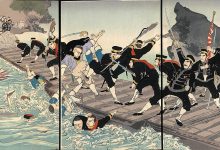The Battle of Hanling (532 CE): A Turning Point in the Wei Dynastic Wars
The Battle of Hanling, fought in the year 532 CE, stands as a significant moment in the tumultuous Wei Dynastic Wars, a series of conflicts that shaped the political landscape of Northern China during the 6th century. This battle, marked by its intense land-based theater and the pivotal clash between Gao Huan and Erzhu Zhao, ultimately determined the course of the Wei dynasty’s fate. The following article delves into the historical background, key participants, strategic decisions, and the broader implications of this landmark confrontation.
Historical Context: The Wei Dynastic Wars
The Wei Dynastic Wars were a series of internal struggles that erupted following the fragmentation of the Northern Wei Dynasty into Eastern Wei and Western Wei. The dynasty’s decline created a power vacuum, leading to infighting among influential military leaders and noble families. This period of instability saw the rise of prominent warlords vying for control over key territories, with alliances shifting frequently to suit strategic objectives.
The battle at Hanling in 532 CE was one of the critical episodes within this broader conflict. It represented not only a clash of military power but also a symbolic struggle for legitimacy and supremacy within the fractured dynasty.
The Battle Overview
- Date: 532 CE
- Location: Near Hanling, in the vicinity of present-day Hebei Province, China. The area lies at approximately 37.8558576 latitude and 114.260893 longitude.
- Theater: Land-based conflict.
- War: Part of the Wei Dynastic Wars.
The battle unfolded as a contest between two key figures: Gao Huan, a rising power in the Eastern Wei faction, and Erzhu Zhao, a prominent general of the rival Erzhu clan, which had once held significant influence in the Northern Wei court.
Key Participants
The engagement at Hanling involved several parties:
-
Gao Huan
As a military leader and eventual de facto ruler of Eastern Wei, Gao Huan was known for his astute political and military strategies. He sought to consolidate power by eliminating rival factions and stabilizing his territory. -
Erzhu Zhao
Representing the powerful Erzhu clan, Erzhu Zhao aimed to maintain his family’s dominance in Northern China. However, his leadership and loyalty faced challenges as the power dynamics within the dynasty shifted. -
Geographical Context
The participants also included forces stationed in or mobilized from regions such as Luoyang, Shayuan, and Heqiao, key strategic locations for supply lines and troop movements.
The Course of the Battle
The confrontation began with both sides positioning their forces strategically in the region of Hanling. While detailed records of troop numbers and maneuvers are sparse, historical accounts suggest that Gao Huan employed superior tactics, leveraging his understanding of terrain and supply lines to outmaneuver Erzhu Zhao’s forces.
Erzhu Zhao’s forces were reportedly overconfident and underestimated the coordination of Gao Huan’s army. This misjudgment led to significant vulnerabilities in their defensive positions. Gao Huan exploited these weaknesses, launching a decisive assault that shattered Erzhu Zhao’s formations. The rout marked a turning point in the conflict, with Erzhu Zhao unable to recover from the defeat.
The Aftermath and Significance
The victory at Hanling solidified Gao Huan’s position as the dominant military leader in Eastern Wei. Following the battle, he continued to exert control over the region, eventually establishing himself as the de facto ruler, even though the Eastern Wei dynasty nominally remained under the rule of puppet emperors.
For Erzhu Zhao and the Erzhu clan, the defeat at Hanling was catastrophic. It signaled the decline of their influence and marked the end of their aspirations for supremacy within the Northern Wei court.
The broader implications of the battle were profound:
- Political Realignment: Gao Huan’s victory paved the way for the establishment of the Eastern Wei as a separate entity, further solidifying the split within the Wei dynasty.
- Strategic Lessons: The battle highlighted the importance of terrain, logistics, and leadership in determining the outcome of military engagements during the period.
Evaluation and Legacy
The Battle of Hanling serves as a testament to the volatility of the Wei Dynastic Wars and the shifting allegiances that characterized this era. Although relatively minor in scale compared to later conflicts, its impact on the trajectory of Eastern Wei and Northern China’s political landscape cannot be understated.
Gao Huan’s rise from this battle marked the beginning of a period of relative stability under his leadership, eventually leading to the foundation of the Northern Qi Dynasty, which succeeded Eastern Wei. The battle also underscores the role of individual leadership in shaping the outcomes of historical events, with Gao Huan’s tactical acumen playing a decisive role in his victory.
Table: Key Details of the Battle
| Aspect | Details |
|---|---|
| Date | 532 CE |
| Location | Hanling, Hebei Province |
| War | Wei Dynastic Wars |
| Theater | Land |
| Key Participants | Gao Huan, Erzhu Zhao |
| Winner | Gao Huan of Eastern Wei |
| Loser | Erzhu Zhao of Wei |
| Significance | Consolidation of Gao Huan’s power |
Conclusion
The Battle of Hanling is more than a historical footnote; it exemplifies the dynamic power struggles of 6th-century China. The victory achieved by Gao Huan not only reshaped the political map of Northern China but also set the stage for the eventual establishment of a new dynasty. Understanding this battle allows modern historians to gain insight into the strategic, political, and cultural transformations that defined the era.

